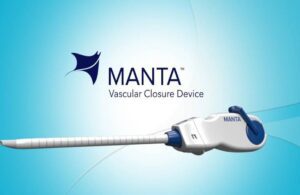
Teleflex (NYSE:TFX) announced today that it enrolled the first patient in a clinical study of its Manta vascular closure device.
In the study, Wayne, Pennsylvania-based Teleflex intends to demonstrate the safety of Manta ultrasound-guided closure without dependence on the pre-procedural depth locator measurements.
According to a news release, the study will enroll up to 150 patients across up to 15 investigational sites in the U.S. and Canada who are undergoing elective TAVR procedures with planned percutaneous femoral arterial access.
The Manta Ultra study is a prospective, multi-center, single-arm trial with a primary safety endpoint of any large bore access-site related Valve Academic Research Consortium-2 (VARC-2) Major Vascular Complication within 30 days. Teleflex said the occurrence of access site complications is associated with higher rates of morbidity and mortality and increased costs associated with prolonged length of stay.
A secondary endpoint is marked by any large bore access-site related VARC-2 minor vascular complication within 30 days (adapted from VARC-2 Criteria) and secondary effectiveness endpoints that include time to hemostasis, technical success, ambulation success, time to ambulation, treatment success and procedure time – all with 30-day and 12-month follow-up time points.
Ultrasound-guided access has been associated with a reduced risk of major and minor access site vascular complications, as well as the reduced risk of life-threatening, major and minor access site bleed complications, the company said. Teleflex plans to explore whether the known benefits of ultrasound-guided access will translate to ultrasound-guided closure and safe Manta device deployment.
Dr. David A. Wood, the head of the VGH division of cardiology and the director of the University of British Columbia Centre for Cardiovascular Innovation is a principal investigator for the study along with Dr. Vijay S. Iyer, chief of cardiovascular medicine and associate professor of medicine at the University of Buffalo (New York).
“The resourcing of the Manta Ultra study by Teleflex reflects our commitment to providing interventional cardiologists and surgeons with category-defining tools that enable difficult procedures and minimize complications – in this case, the complications attributable to large bore access that are inherent to TAVI procedures,” Teleflex Medical Director Dr. Chris Buller said in the release.